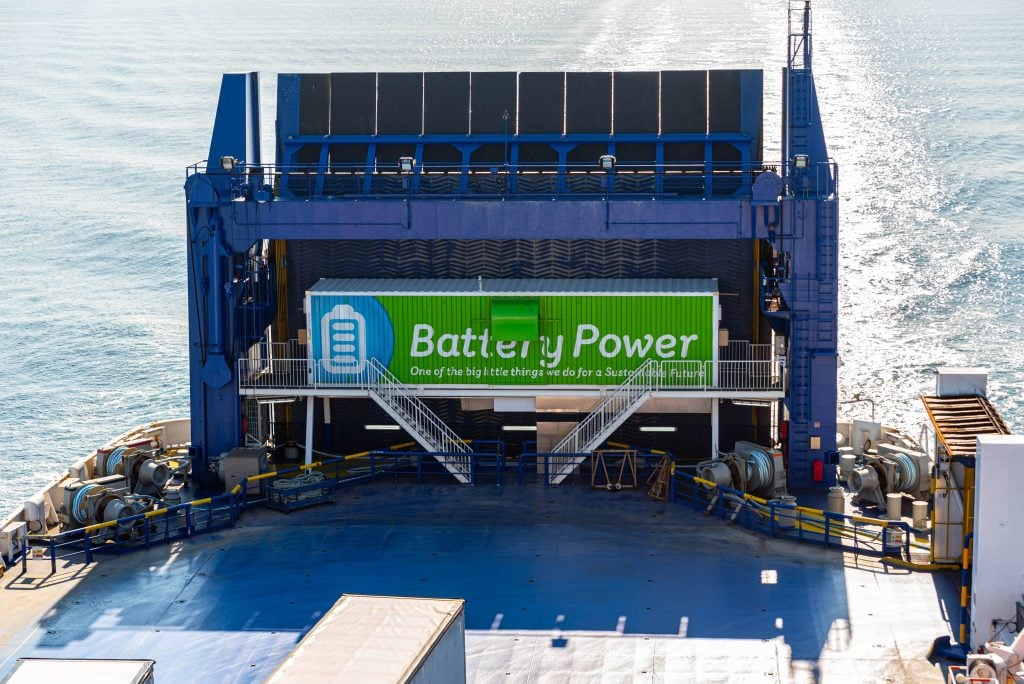Could 40% of global containership traffic be fully battery powered by 2030?

Researchers have made the bold claim that rapid price falls in commercially available batteries could allow for more than 40% of global containerships traffic, representing the entirety of intra-regional trade, to be fully electrified within the next decade.
A paper, published in July in nature.com, the online resource for the leading international weekly journal of science Nature, claims that the widespread uptake of such batteries would be cost effective, in part as they would be able to incorporate commercially available batteries with current shipboard technology. The research assumes a battery cost of US$100 kWh−1 and notes ships powered by battery would become economical over trade routes of less than 1,500 km “with minimal impact to ship carrying capacity”.
This cost effective distance (equivalent to the straight-line distance between London and Copenhagen) means that all intra-regional shipping could be retro-fitted or replaced with battery powered engines. If applied to US shipping, the paper claims it would reduce the CO2 emissions of the sector by 14%.
However, Gareth Burton, Vice President of Technology at the American Bureau of Shipping (ABS) expressed a degree of scepticism regarding the paper’s conclusions, noting the sizable challenge to meet the paper’s proposed 40% target would mean both newbuilds and existing builds would all need to use batteries. He continued: “Extending the application of batteries to the point where deep-sea vessels can operate solely on batteries presents challenges, requiring significant developments in battery technology.” Burton added that battery technologies will be more swiftly adopted in “short sea vessels, and feeder vessels for specific applications”.
Burton is not the only industry figure to express doubts regarding the wider applicability of battery power. Despite battery power being far and away cleaner than conventional Heavy Fuel Oils (HFOs), there is currently no meaningful parity between the two in terms of energy efficiency by weight. Even the most high tech battery solutions do not exceed 300 Wh/kg, compared to 11,400 Wh/kg for HFOs. The paper’s authors estimate that for a 5,000 km range small neo-panamax ship, the batteries would need to weigh 20,000 tonnes even at state-of-the-art efficiency levels. This is a figure that may deter all but the most ambitious early adopters of renewable energy.
Uptake of 40% of the containership fleet could also be hindered by the fact that R&D into the commercialisation of battery technology still needs to be done to make battery technology safe and widely available. A paper by the Royal Society of Chemists argues “All of the current lithium-ion batteries use flammable organic electrolytes… [which can lead] to fires that are very difficult to extinguish.” Solving this engineering problem presents a real challenge that has yet to be solved by the scientific community, and more investments are needed in R&D to resolve them. Figures from the International Energy Agency show that private sector R&D spending in maritime has fallen from 2.7 billion USD in 2017 to 1.6 billion USD in 2019.
While such a high uptake of battery technology may presently be hindered, the authors of the paper remain hopeful for the impact battery power can have for shipping’s green goals.
“Battery-electric propulsion has been underexplored as a potential low-emissions alternative in the marine shipping sector despite recent decline in battery costs; improvements in battery energy densities; increasing availability of low-cost, renewably generated electricity; and its substantial efficiency advantage over e-fuels such as green hydrogen and ammonia,” write the researchers from the University of California, Berkeley.
The paper’s modelling rests on the assumption that ships can be recharged at both origin and destination. However, it also highlights the potential for creating large charging infrastructure in global choke points such as the Suez canal, which force ships to periodically remain stationary.
This is a view also shared by Robert Palin, MD at Spaera, a green shipping tech start-up. Palin said ‘there’s [also] the possibility of having autonomous floating ‘supercharger’ islands, also using solar/wind/wave power with batteries to recharge a ship mid-way.’ While seemingly ‘fantastical’, Palin argued that similar large scale marine infrastructure such as offshore oil platforms seemed just as improbable at first.
Indeed, while further R&D and infrastructure investments are required to make batteries a viable option in the coming decade, there have been encouraging signs that battery power could be an important part of cruisers and passenger ferries with a few significant early adopters in Scandinavia and Japan.
Related content

ICS Pleased with IMO Progress on Environmental Issues

Environmental Organizations and Shipping Industry Call For Carriage Ban on Non-compliant Fuel

Progressing port transparency on alternative fuels
